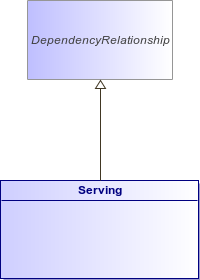
ArchiMate Metamodel
The serving relationship describes how the services or interfaces offered by a behavior or active structure element serve entities in their environment. This relationship is applied for both the behavior aspect and the active structure aspect.
Compared to the earlier versions of this standard, the name of this relationship has been changed from 'used by' to 'serving', to better reflect its direction with an active verb: a service serves a user. The meaning of the relationship has not been altered. The 'used by' designation is still allowed but deprecated, and will be removed in a future version of the standard.
The usual interpretation of a serving relationship is that the whole of the source element serves (is used by) the target element. This means that if, for example, two services serve the same internal behavior element, both of these services are needed. If two services are alternative solutions and only one of them is needed by the internal behavior element, an or junction (see Section 5.4.3) can be used.
